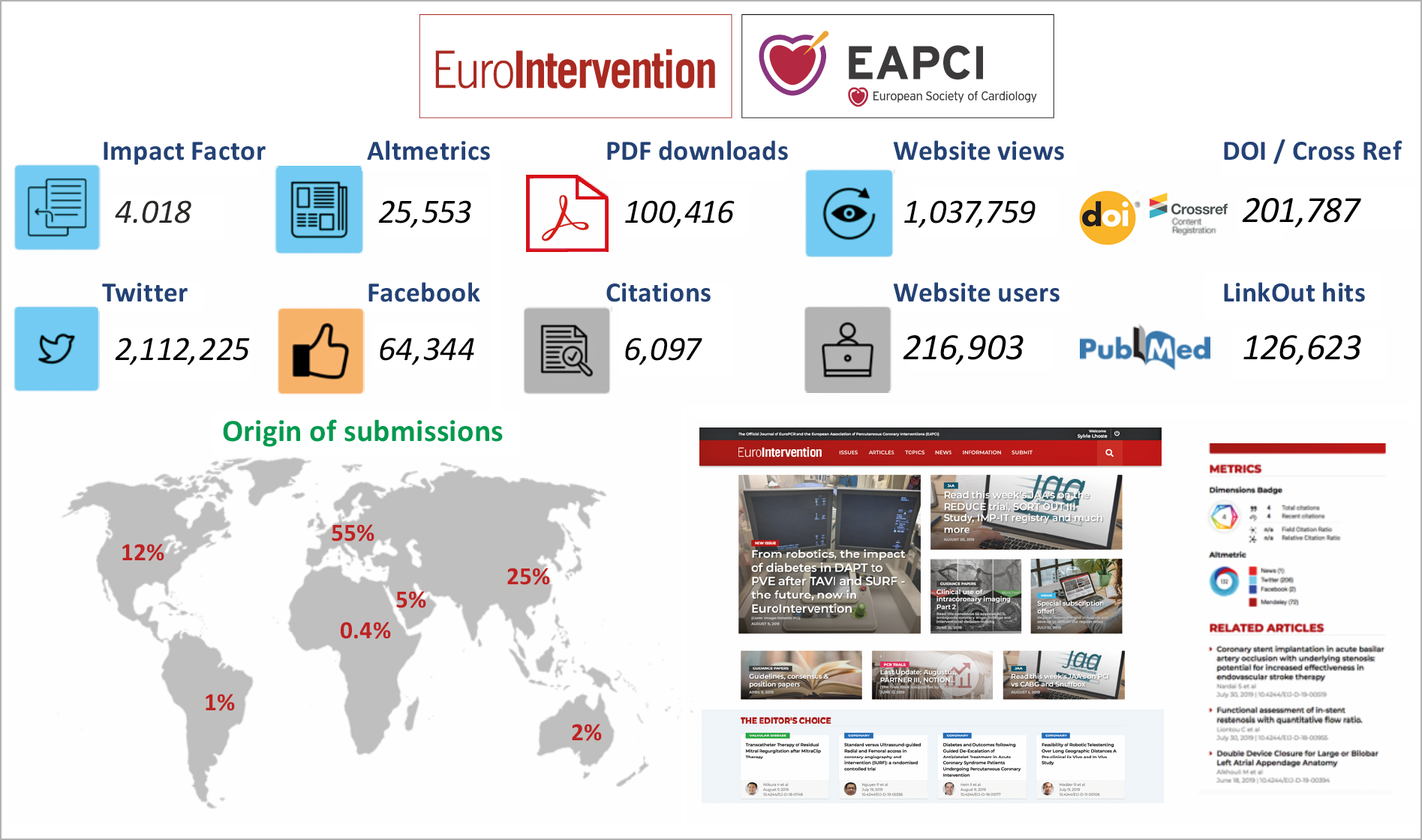
Once a year the editorial office of EuroIntervention presents to the editorial board the statistics concerning the Journal’s performance over the previous 12 months. Traditionally, these have been short presentations with prompt adjournment for refreshments. More recently, the emergence of the digital era has provided the Journal with a multiplicity of interesting metrics which detail the Journal’s exploits in the scientific, social media, and print realms. The refreshments are consequently postponed until these intriguing data have been discussed, debated, and digested by the board. This editorial provides an opportunity to disclose these statistics and the Journal’s response to them. The readers are encouraged to draw their own conclusions regarding the health of the Journal.
The heartbeat of a journal is the scientific content it publishes. By extension, the number of submissions to a journal could be considered analogous to the heart rate; a greater volume of submissions suggests a fitter journal, but sustaining the higher rate necessitates more work for the editorial board, office, and reviewers alike. In 2018, EuroIntervention received 1,203 submissions, an increase of 3.8% on 2017. A geographic shift is evident in the origin of these research papers: Europe (55%) continues to account for the majority of submissions but the Middle East (5%) and China (25%) have increased in recent years while the USA (12%) remains stable. The Journal truly has a global reach. We remain sincerely grateful to our hundreds of committed reviewers who have responded admirably to the increased volume of submissions and the requirement for more efficient processing of this content. The editorial team continues to try to limit the burden on our reviewers by scrutinising closely the quality of submissions and only allowing those of real substance (circa 60%) to enter the review process. These collective efforts have reduced the average time taken from article submission to editorial board decision from 28.2 days in 2015 to 17.9 days in 2018. For prospective authors this rapid review process is attractive.
Foremost among the relevant Journal statistics for 2018 is the impact factor (IF), which currently resides at 4.018 (Figure 1). Although the IF has many detractors, it remains the benchmark on which scientific journals and their content are judged. Researchers intuitively submit their work for publication to the journal with the highest IF possible, a practice endorsed by universities and funding organisations alike. Improving the IF remains therefore a key objective of the Journal’s editorial and publishing teams. A journal’s IF is calculated by dividing the total number of citations in the last year (from articles published in the previous two years) by the number of citable articles in the previous two years. If the number of citations decreases or the number of citable articles increases, then the IF falls. In the case of our Journal, citations increased from 5,742 in 2017 to 6,097 in 2018. Yet, the Journal’s IF decreased from 4.417 in 2017 to its current level. The reduced IF is a result of an increase in the number of articles deemed citable by Thomson Reuters between 2016 and 2018. Put simply, the Journal has published too many articles that are not cited or citable, despite being relevant to the readership. The editorial team have introduced several enticements to encourage authors to submit higher-quality research to the Journal, including expedited electronic publication, rapid or fast track review, e-blasts, greater online visibility via the social media team, etc. We also need to limit the quantity of non-citable material in the Journal. The number of articles published per edition of the Journal, and consequently the acceptance rate (14%) for clinical research papers, has been reduced over the last 12 months. In addition to disseminating important scientific content, we will continue to publish material that our readership digest en masse, such as technology updates, flashlights, consensus documents, state-of-the-art reviews, and the recently introduced perspectives from leaders in our field. A review of the Journal’s most downloaded articles in 2018 affirms how important this content is to our readership1,2,3; eight of the top 10 provide practical guidance for performing complex coronary interventions!

Figure 1. The EuroIntervention health check 2019.
A variety of “alternative” statistics that evaluate the Journal’s reach and performance beyond the traditional scientific literature are becoming increasingly important. The Altmetric “attention” score encapsulates the online influence of a journal article and is calculated by combining all online interaction with the publication, including a post/share on Twitter, a like on Facebook, a LinkedIn or Research Gate post, a blog discussion, addition to an online citation manager, a company e-blast, etc. The score is presented as a badge or interactive visual display that expresses the citation data for individual publication. In 2017, the Journal’s total Altmetric score was 13,638. This score increased nearly twofold to 25,553 in 2018. Similarly, Facebook likes, shares, comments, and/or clicks increased 16% to 64,344 in 2018 and Twitter impressions increased 145% to 2,112,225 in 2018. These impressive social media data are in no small part due to the excellent work of the editorial office, our publisher Europa Digital, and the Social Media Team led by Salvatore Brugaletta.
As traditional media continue to decline, it is important that the Journal continues to focus on an online footprint and the development of digital content. The Journal’s website traffic continues to increase year on year and, for the first time in 2018, EuroIntervention.com surpassed one million annual page views (1,037,759). A total of 216,903 individual users accessed the website in 2018, an 11% increase on 2017. Moreover, the number of article downloads from the website increased from 90,794 in 2017 to 100,416 in 2018 (an 11% increase). The launch of the new and improved website in April 2019 is timely and should allow the Journal to continue its upward trajectory in the digital era.
We believe that our Journal, the official Journal of the EAPCI, is in rude health and is in an excellent position to lead the cardiovascular publishing space in the ongoing transition from print to digital media. The Journal must not stand still however, and the ability to offer our readership new content and resources in a financially constrained system remains challenging. In this context, Europa Publishing has announced its intention to introduce a subscription to access components of the Journal (more on this at a later date). The Editors are aligned with this new reality but continue to advocate for the vast majority of the Journal’s content to be freely available without a pay wall. We are confident that our strategic development plans and editorial decisions will allow the Journal to thrive in the ultra-competitive cardiovascular market and will ultimately increase the quality and sustainability of the Journal. Charles Darwin put it best, “It is not the strongest of the species that survives, nor the most intelligent; it is the one most adaptable to change”.

